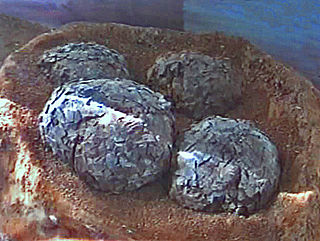 W
WThe Anacleto Formation is a geologic formation with outcrops in the Argentine Patagonian provinces of Mendoza, Río Negro, and Neuquén. It is the youngest formation within the Neuquén Group and belongs to the Río Colorado Subgroup. Formerly that subgroup was treated as a formation, and the Anacleto Formation was known as the Anacleto Member.
 W
WAbelisaurus is a genus of predatory abelisaurid theropod dinosaur alive during the Late Cretaceous Period (Campanian) of what is now South America. It was a bipedal carnivore that probably reached about 7.4 metres in length, although this is uncertain as it is known from only one partial skull.
 W
WAerosteon is a genus of megaraptoran dinosaur from the Late Cretaceous period of Argentina. Its remains were discovered in 1996 in the Plottier Formation, dating to the Santonian stage. They were originally described as coming from the Anacleto Formation. The type and only known species is A. riocoloradense. Its specific name indicates that its remains were found 1 km north of the Río Colorado, in Mendoza Province, Argentina.
 W
WAntarctosaurus is a genus of titanosaurian sauropod dinosaur from the Late Cretaceous Period of what is now South America. The type species, Antarctosaurus wichmannianus, and a second species, Antarctosaurus giganteus, were described by prolific German paleontologist Friedrich von Huene in 1929. Three additional species of Antarctosaurus have been named since then but later studies have considered them dubious or unlikely to pertain to the genus.
 W
WAucasaurus is a genus of medium-sized theropod dinosaur from Argentina that lived during the Late Cretaceous of the Anacleto Formation. It was smaller than the related Carnotaurus, although more derived in some ways, such as its extremely reduced arms and almost total lack of fingers. The type skeleton is complete to the thirteenth caudal vertebra, and so is relatively well understood, and is the most complete abelisaurid yet described. However, the skull is damaged, causing some paleontologists to speculate that it was involved in a fight prior to death.
 W
WGasparinisaura is a genus of herbivorous ornithopod dinosaur from the Late Cretaceous.
 W
WMegaloolithus is an oogenus of dinosaur egg. Some eggs belonging to this oogenus may have been laid by the titanosaur Hypselosaurus. They are known for having thick eggshells, at least 1.5 millimetres (0.059 in) thick, and the nearly spherical shape of the eggs. They are primarily found in India and Europe, but some specimens have been found in South America.
 W
WNeuquensaurus is a genus of saltasaurid sauropod dinosaur that lived in the Late Cretaceous, about 80 million years ago in Argentina and Uruguay in South America. Its fossils were recovered from outcrops of the Anacleto Formation around Cinco Saltos, near the Neuquén river from which its name is derived.
 W
WOverosaurus is an extinct genus of sauropod dinosaurs, containing only a single species, Overosaurus paradasorum. This species lived approximately 86 to 84 million years ago during the latter part of the Cretaceous Period in what is now Patagonia. Overosaurus paradasorum was relatively small compared to other sauropods from Patagonia, like the saltasaurids and other aeolosaurines. It was a ground-dwelling herbivore, relatively small for a sauropod, with a length estimated as approximately 10 m (33 ft) long.